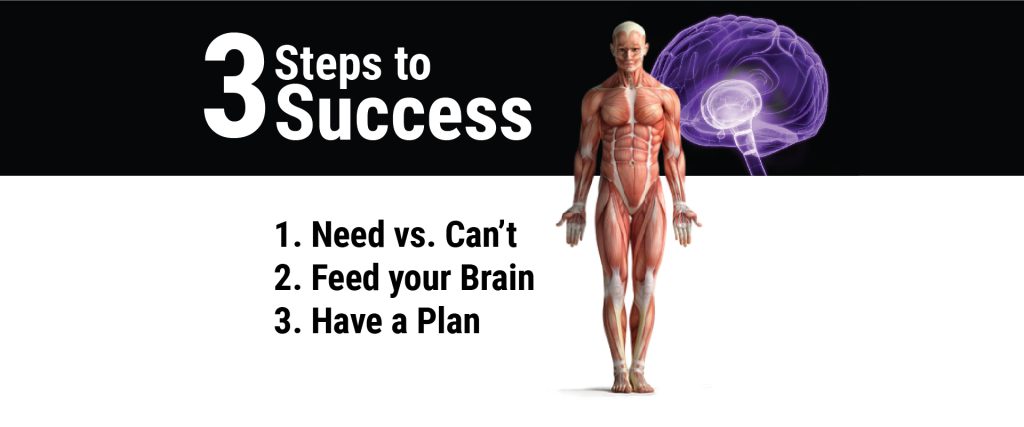Why are Doctors Calling Vitargo ‘Fighters Gold?’
19 July, 2019
Blog
Three Steps to Success
By: Dr. Sue Kleiner

While this may sound simple, one of the hardest parts of creating lifestyle change is figuring out where to begin. Here are my three steps to success that I share with my clients, from the average person who wants to feel better to elite athletes who are going for gold.
Step 1: Focus on what you need to eat, not what you can’t eat next
When we interview folks who have lost weight and successfully maintained their weight loss over many years, they report a few common life strategies that have worked for them:
- Eat the food that you love, but less of it
- Eat more plants
- Drink more water
- Exercise every day, or almost every day, forever
Nowhere in that list are foods that you should restrict or avoid. On the contrary, success stories seem to be based on what you need to eat, not what you can’t eat next.

Step 2: Feed Your Brain
The standard message about eating a plant-rich diet applies to your brain as well as your body, but there are some important details that you shouldn’t miss.
Carbohydrates
Somehow the conversation always comes back around to carbohydrates, but this time it’s about how much you need to eat, not how little. Emotional well-being may be affected by how much carbohydrate is in your diet. Widespread anecdotal reports tell the stories of emotional swings, poor anger management and generally low mood in people trying to follow low carbohydrate diets. According to research, diets that are less than 40 percent of total calories from carbohydrate can be depressing in depression-prone individuals.
What food to include? All plants: whole grains, beans, fruits and vegetables. There’s also some carbohydrate in milk and dairy products, depending on the product. You should also have enough carbohydrate to use it in a targeted way to fuel your high-intensity training. That’s how I use Vitargo, a superfast pure starch sports drink, to fuel training and recovery.
Egg yolks
Choline, a B-vitamin, is half of the most abundant neurotransmitter in our bodies, acetylcholine, which works every time we think or move: 24/7. Choline is also required to support the creation of channels in our brain cell membranes so that nutrients can pass into and toxins can pass out of brain cells. Without choline we don’t feel, think or move very well. Egg yolks are the primary source of choline in the US diet, and as a nation, we have become marginally deficient in choline as we dumped egg yolks down the drain.
Numerous research studies have shown that egg yolks do not raise cholesterol levels in healthy people. To have a healthy brain and feel and perform at your best, start to eat the whole egg. I recommend one whole egg daily.

Fish, Flax, and High-Performance Fat
The concentration of DHA in brain cells, the oil found mostly in fish, determines the health of the brain cell membrane and its ability to receive and transfer messages from one cell to the next. Eating wild salmon, low-mercury tuna, mackerel, sardines, anchovies, herring, and shellfish is good for your brain as well as your heart.
The same goes for adding 1-2 tablespoons of flaxseed meal to your diet. The seeds must be ground or the seed’s inner goodness and fat-busting qualities will pass right through you. Along with the important oils, an added benefit is that the fiber in the seeds is great food for your gut biome.
Step 3: Plan for Success
Are you tracking? Most people with goals have either been tracking or still are tracking habits. But tracking is retrospective; it acknowledges that you did what you had hoped you would do. The opportunity for success, however, is much more likely if you plan ahead in a regimented way exactly what, when and where you will make your habit change. Then track whether you did it, and how comfortable it felt to do the new habit rather than an old one.
To accomplish goals, you must have a targeted plan. There’s an old saying that “a goal without a plan is just a wish”. The New Power Eating (Human Kinetics, 2018) has a Success Tracker in Chapter 13 on how to develop your plan. It will explain how to plan your change into your life in a very targeted way, and then track it in the tool for 10 weeks. At that point, the old habit should be gone and the new, feel-good habit has become, well, a habit, seamless in your day.

Also, try adding Vitargo around your workout to rehydrate, refuel and recover faster. It’s easy, it’s proven, and it works to change your game, your mind, and your body.
featured blogs



